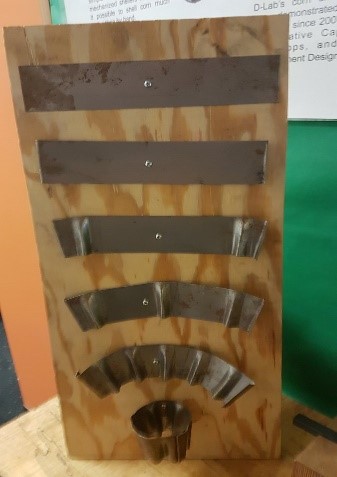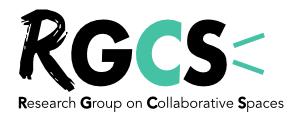Between the 25th and the 28th of July 2018, I have had the opportunity to participate to a very rich learning expedition organized by the Research Group on Collaborative Spaces (RGCS), an alternative academic network about new work practices inspired by open science and citizen science cultures.
The expedition called #hackingday2018 consisted in a set of visits and reflexive discussions about Boston’s academic, entrepreneurial and innovative eco-system*. We followed a protocol combining planed with improvised visits following the flow of discussions and questions of the event itself (see the OWEE protocol for more details). More than two thirds of the visits were thus improvised. The protocol also relies on openness (anybody can register for free via an Eventbrite link) and long walked times alternating visits and other seated times. Social media, blogs and videos are used to extend the event in time and space, and link it to other events and published research. Thus, serendipity, by chance encounters, reflexivity and narration are strongly part of this journey which lead us at Media lab, Harvard’s Wyss Institute, CIC, WeWork, MIT makerspace, TMRC and different MIT labs.
I want to focus here on two visits that followed each other and inspire me a more systematic comparison between two different philosophies of innovation and their political consequences for society.
We first visited the Center for Bits and Atoms (CBO), part of the MIT media lab, in which fab labs were co-invented. The center for bits and atoms is presented as an “an interdisciplinary initiative exploring the boundary between computer science and physical science. CBA studies how to turn data into things, and things into data.” (Source: CBA website) The CBA includes in its main building projects, startups, facilities such as 3D printers, genomics oriented-tools, laser cutters, CAT scanners, etc. It was launched by a National Science Foundation award in 2001 (source: CBO website). The idea was to “create a unique digital fabrication facility that gathers tools across disciplines and length scales for making and measuring things.”
Visiting this place was very interesting for me, as part of my research is focused on collaborative spaces such as makerspaces, hackerspaces and fab labs. CBA is for me an iconic, mythical space, as it is the place where part of the story of open knowledge oriented-places began. The fabrication laboratory (fab labs) program started here with CBA. As narrated by its Wikipedia page, the fab lab program was “initiated to broadly explore how the content of information relates to its physical representation and how an under-served community can be powered by technology at the grassroots level.”. The first fab lab has been launched in India in 2002, just one year after the beginning of the project.
What is a fab lab? It is a fabrication-oriented place whose community document and share the processes it co-produces. It has to respect the key principles of the fab lab charter. The charter stresses also the importance of the fab labs network, and the possibility for patents and private sponsorship but with an important condition: “Designs and processes developed in fab labs can be protected and sold however an inventor chooses, but should remain available for individuals to use and learn from.”
Interestingly, another MIT center was part of the elaboration of this innovative concept: the Grassroots Invention Group which is no longer part of the MIT media lab. The Grassroots Invention Group (GIG) is “developing a suite of low-cost, powerful personal computation and fabrication technologies along with innovative idea dissemination methodologies to give individuals and communities greater independence over their own learning and development”. Interestingly, GIG is rarely mentioned in the articles we read about fab labs history or philosophy, but its joint imprint is obvious, in particular in its objectives. The website stresses that “We are actively working with our international partners to ensure that the tools we build and disseminate can be locally reproduced, extended and appropriated in a variety of social, cultural and economic context.” The idea is to document procedures, ideas, concepts that can travel it time and space. They appear locally, are co-production, which need (in particular with the help of digital tools such as wikis) to be shared and appropriated by other people.
To come back to our CBA’s visit, I have been impressed by the tools and facilities accessible to MIT students and outside projects. I have also seen fascinating private projects I will not mention here. Most of all, I found very interesting the presence of pedagogy and students at CBA, and the multiple departments connected to the place. Interdisciplinarity is an obvious practical thing here. And the course “How to do (almost) anything” (set up by Neil Gershenfeld) which is part of the original story about fab labs’ birth is among the three most requested courses at MIT. Impressive. But (is that surprising for an independent, open movement?), fab labs, the myth, visuals, concepts around them, were absent from the spaces I visited.
Less than one hour later, we explored another place of MIT, the D-lab, with both a close and a different philosophy. from that of fab labs. D-lab is much more socially and politically grounded in the space itself of the MIT. MIT D-lab website states: “MIT D-Lab works with people around the world to develop and advance collaborative approaches and practical solutions to global poverty challenges.” Likewise, it stresses an interdisciplinary orientation (in particular in the courses) and research in “collaboration with global partners, technology development, and community initiatives — all of which emphasize experiential learning, real-world projects, community-led development, and scalability.”
The place has been founded in 2002, with a strong focus on developing countries’ needs. Although not as widespread as the fab labs network (which is outside MIT structure), D-lab has an amazing international inscription and is connected to communities in “Botswana, Brazil, Colombia, El Salvador, Ghana, Guatemala, India, Indonesia, Haiti, Ghana, Mali, Morocco, Nicaragua, Pakistan, Peru, Philippines, Tanzania, Uganda, Zambia, and others.” (Source: D-lab website).
I want to stress here two interesting times of the visit of the lab: the presentation of a corn sheller and the presentation of a mechanical washing machine rotated by a bike (see the two pictures below in figure I).
 |
 |
- Figure I: A mechanical washing machine and a corn sheller presented at D-lab (source: author’s own, picture taken during the visit of the lab).
In both cases, the gestures, habits, embodied practices of the community and its needs are both the starting and final points of the co-creative process. Documentation is more about the method and the output which is expected to be documented and diffused globally.
Local availability of skills, knowledge, objects and gestures is key. If you have barrels around you, do something with barrels…
This philosophy is interesting to compare with the more digital, global sharing, network grounded, and documentation focus of fab labs. In the context of fab labs, the ultimate goal is about co-producing a common for society. Interesting ideas can travel in time and space, be full of improvisations and bricolages in their local co-production, and be also adapted later in their appropriation in other local contexts. The use of (still) costly tools can help to also represent the object which will be later produced with the laser cutters, 3D printer, water cutters and other tools likely to be produced locally as well.
In contrast, D-lab has no expectations about a pre-existing set of tools or skills, and starts with the embodied practices of the community. The possible commodification of the knowledge, the articulation of business is not part of the story. Both philosophy could be presented the following way:
|
FAB LAB MODEL
|
D-LAB MODEL |
|
|
Focus
|
Both the Fab lab network and local communities
|
Mainly and ultimately the local community |
| Resources | Knowledge and skills documented by the network, local knowledge and skills. Digitalization of skills and projects in the spirit of a common good for fab labs community and society at large | Gestures, skills, available objects on site, embodied practices. The local community is the both the starting point and final destination. |
|
Property
|
Both private and open. Access to facilities and knowledge is a key thing. | Not really the key issue as available objects, gestures and technologies are at stake. Out of reach of effective or potential platforms and markets in a way. |
- Figure 1: The fab lab and D-lab models of innovation (source: author’s own)
Of course, both model presented here are just ‘archetypes’ and for sure D-lab model exist in the practices of local fab labs practices, and vice versa. And to come back to the example of the mechanical washing machine (which is a re-invention of an old technology), the tripod at the back of the bicycle could perfectly be a fab lab documented and engineered technology. Both approaches are for sure largely complementary.
But what I found interesting, is that they are not ‘open’ the same way, and do not raise the same legal and political questions for society and the urgent issues we are coping with in the world.
To be continued…
François-Xavier de Vaujany, PSL, Université Paris-Dauphine (DRM)
* I want to thank here Aurore Dandoy and Annie Passalacqua for their great animation and active co-production of this exciting event in Boston. I also thank PSL university and university Paris-Dauphine for their support.
